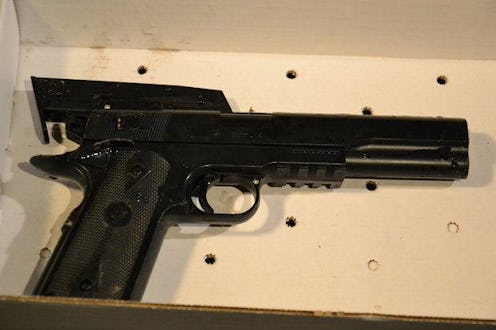News
Should Fake Guns Be Brightly Colored By Law?

This past Saturday afternoon's shooting death of Ohio 12-year-old Tamir Rice by Cleveland police has cause shockwaves in more ways that one — in addition to an outpouring of support from people whose hearts are broken by the shooting, which the Cleveland Police Department blamed on Rice's airsoft gun having no marking identifying it as such, there's now a legislative effort afoot in response to ensure that such replica firearms will be a little easier to spot. Basically, the Tamir Rice shooting inspired a colored fake gun bill from an Ohio state Democratic legislator named Alicia Reece.
In simplest terms, Reece is aiming to reduce the risk of civilian death by police by making the kinds of realistic-looking replica guns Rice was carrying look more obviously fake. And in truth, the Rice tragedy isn't the only incident that spurred Reece to back the effort — the bill is actually titled "John Crawford's Law," in reference to the 21-year-old black man who was slain by police in an Ohio Walmart in August. Like Rice, Crawford was carrying a realistic-looking toy gun (Rice's was a handgun model, while Crawford's was a rifle) when a bystander placed a 911 call, ultimately resulting in his death at the hands of the responding officers.
So, what exactly is the current state of the law about these replica guns? As it stands now, actually, there is a federal law on the books dictating that "toy, lookalike, and imitation firearms" are required to have any of a number of design elements making their relatively harmlessness obvious — an orange tip, for example, or a plastic body that shows the inner construction of the gun. However, the law is wildly ineffective, as it grants exemptions to a category of replica guns broad enough to defeat the purpose.
This part does not apply to ... Traditional B-B, paint-ball, or pellet-firing air guns that expel a projectile through the force of compressed air, compressed gas or mechanical spring action, or any combination thereof ...
To address this loophole, some state governments have stepped up — the John Crawford's Law proposal is reportedly modeled on California's law relating to recreational fake firearms, which works towards a similar goal — making sure everyone who sees one of them is given the utmost confidence it isn't real. After a 13-year-old boy from Santa Rosa was slain by police while carrying an airsoft rifle, the state legislature passed a law requiring all fake guns to feature fluorescent markings — more or less the same set of circumstances as happened to both Crawford and Rice.
Reece's bill, just like the law passed in California, will be met with opposition from pro-gun groups like the NRA, but she's undeterred, viewing this as a common-sense way to cut down on needless deaths according to WLWT.
We’re talking about human life. You can’t put a dollar sign on human life. If changing a color or adding a strip is going to save a human life, save a community or a city or state from losing a human life then I think the price is worth it.
WLWT also spoke to Robert Sacco, the head of Ohio's Pistol and Rifle Association, who opposes the law on the grounds that people can just alter their gun's coloring to make it look more realistic anyways.
Coloring the front end of air soft, BB guns or other air weapons bright colors does not prevent anybody from either painting over or taping over them and once again they appear to be real weapons.
Obviously, this raises the question of why such groups care about opposing the law — if it's easy enough to tamper with your gun to make it look real, then what's the problem? Reece is planning to introduce the bill on Monday, and it'll be interesting to see whether recent events propel it over the finish line — Ohio's state legislature, after all, is dominated by the Republican party, and if there's anything Republicans hate, it's regulation that pro-gun groups disapprove of.
Images: Paula Bolyard/Twitter